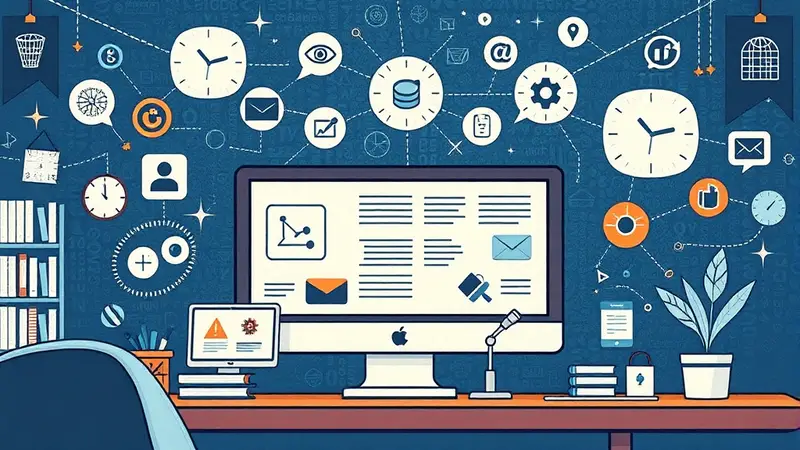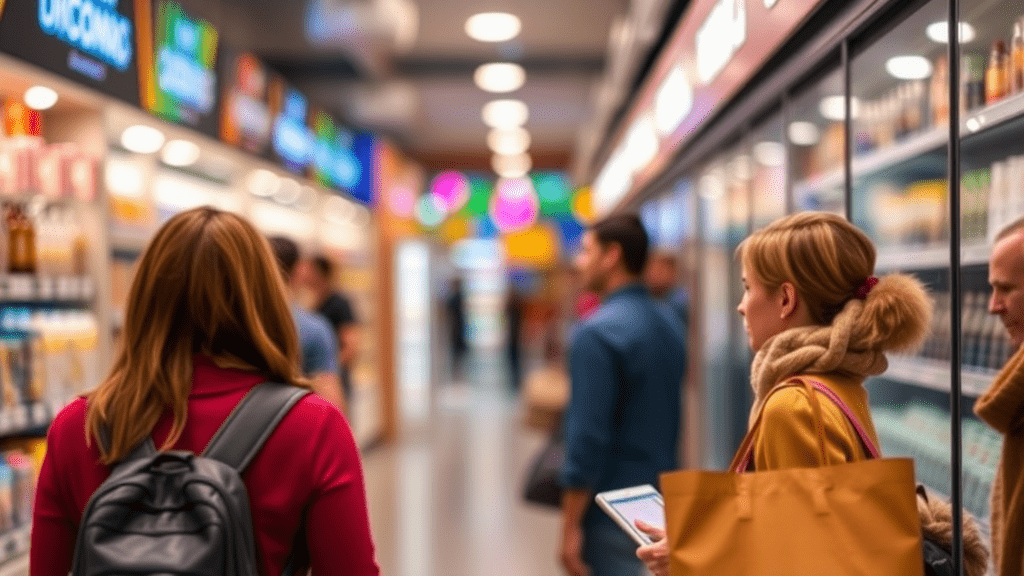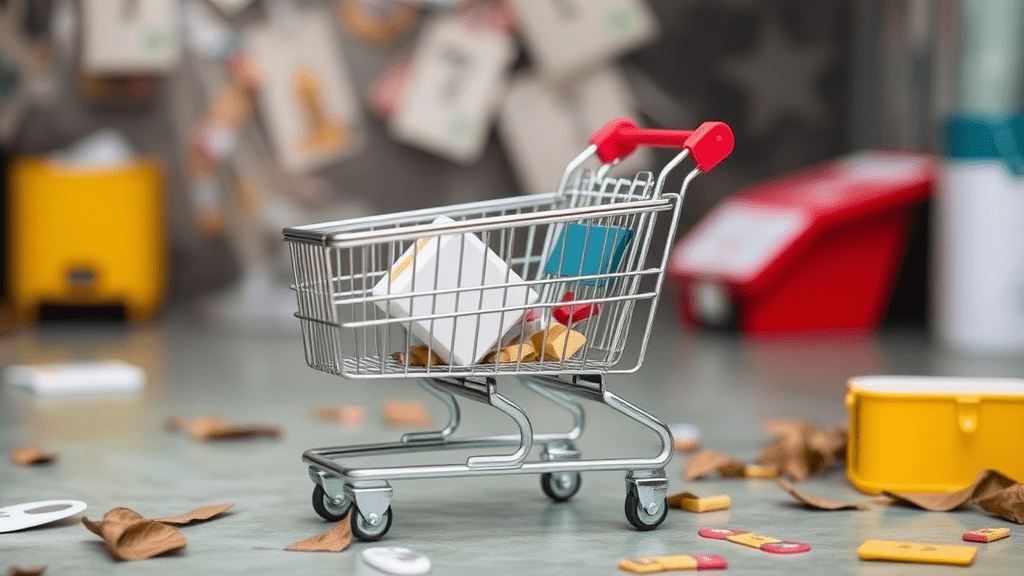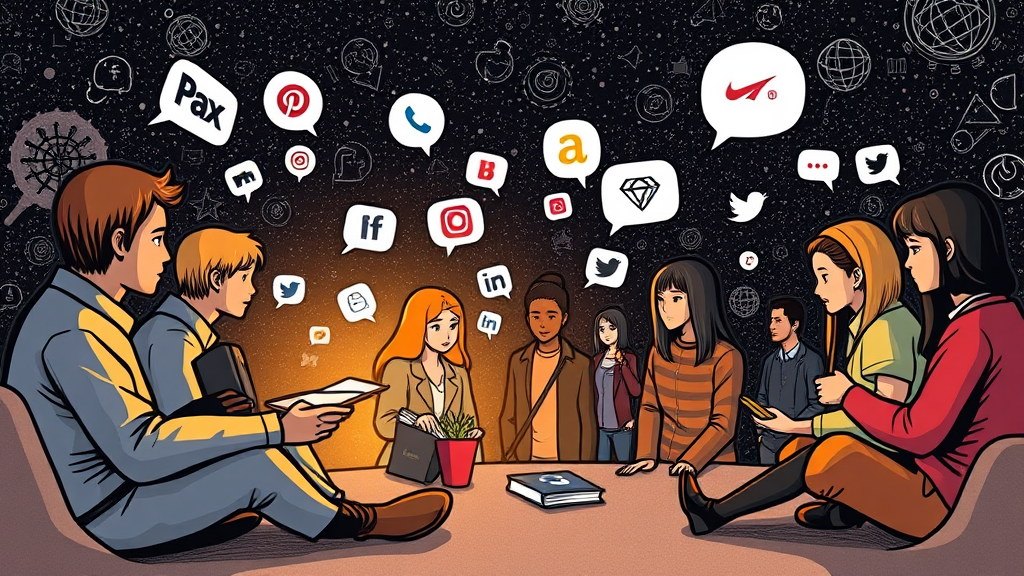Emotions often drive consumer behavior long before logic steps in. For small business owners and e-commerce entrepreneurs, tapping into these subconscious motivators can be the key to standing out in a competitive marketplace. Whether it’s the excitement of a limited-time discount or the comfort of strong security measures, emotional triggers influence purchasing decisions and elevate a brand’s appeal.
This post uncovers seven powerful emotional triggers that help boost online sales and strengthen customer loyalty. Each section explores the psychology behind a specific trigger, real-world examples of brands applying it effectively, and actionable steps you can implement right away. By understanding these emotional drivers, you’ll be better equipped to craft a shopping experience that resonates deeply with your audience.
Why Emotions Matter in Online Shopping
Online shopping is no longer just about product features or competitive prices. Emotions play a substantial role in every customer’s journey, driving decisions often before logic even comes into play. Consumers gravitate toward products that spark excitement, soothe anxieties, or resonate with their aspirations. By tapping into these emotional motivators, businesses can create deeper connections with their audience and encourage faster, more confident purchases.
Research suggests that up to 95% of purchasing decisions happen at the subconscious level, where emotional triggers hold powerful sway. Once an individual feels a certain way—be it intrigued, anxious, or thrilled—logical reasoning often follows to justify the emotional impulse. Understanding these triggers allows e-commerce brands to craft experiences that not only lead to immediate sales but also foster long-term loyalty.
The scientific explanation behind this phenomenon is tied to how the brain processes emotions. When potential customers browse online, they’re subconsciously assessing risk, trust, and personal benefit. If these factors align with the right emotional cues, a surge of dopamine often follows. Dopamine is frequently associated with pleasure, reward, and anticipation—key sentiments that make shoppers more likely to click “Buy Now.” This is especially significant in an online context where endless options can overwhelm consumers. Emotional hooks simplify decision-making and channel attention toward compelling offers.
Emotions matter because they make online interactions personal. A well-structured product page can help visitors visualize ownership, see themselves enjoying the benefits, or avoid missing out on a great deal. It’s this internal spark—whether fueled by excitement, relief, or a sense of urgency—that transforms casual browsers into committed buyers.
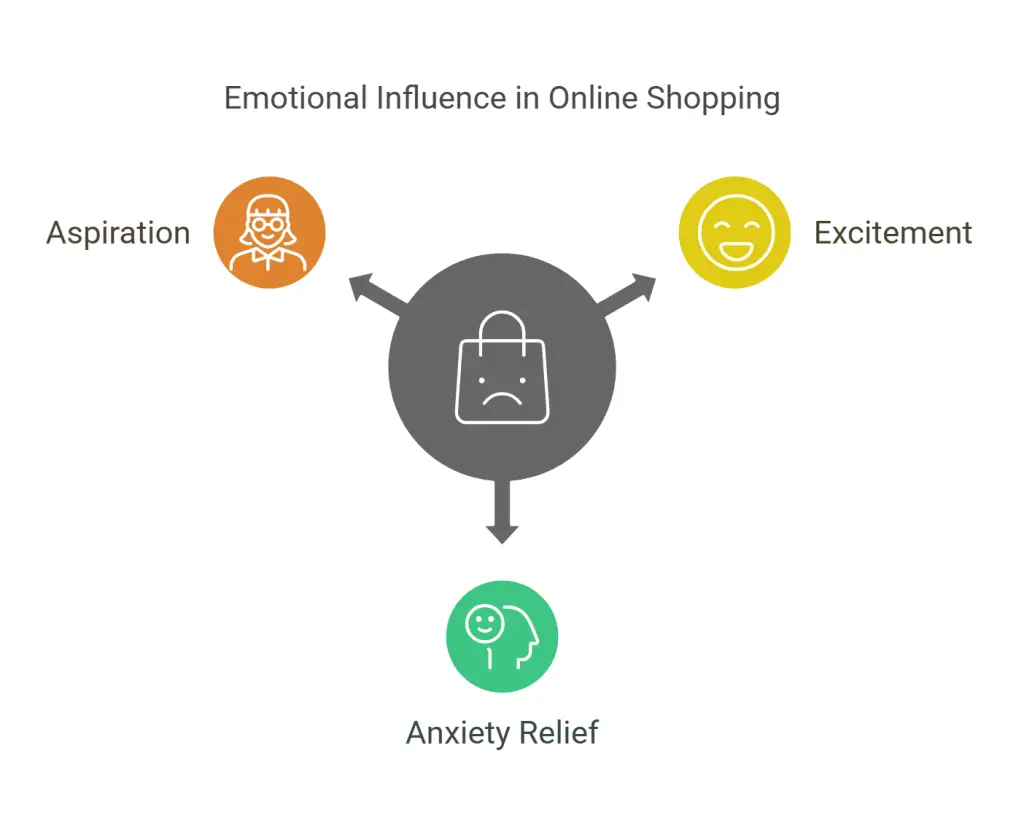
The 7 Most Powerful Emotional Triggers in Online Shopping
1. Urgency & Scarcity (Fear of Missing Out – FOMO)
The psychology behind urgency and loss aversion.
Fear of missing out taps into a deep-seated aversion to loss. If customers believe they may lose an opportunity, they act more swiftly. It’s why limited-time deals, countdown timers, and scarcity messages effectively spur quick decisions.
Why limited-time offers and low-stock notifications push people to act fast.
A flash sale expiring in a few hours introduces a ticking clock that heightens anxiety about missing a good deal. Similarly, a “Only 3 left in stock!” alert ignites a feeling of urgency, suggesting that hesitation might result in losing out.
How to Apply This:
- Countdown timers: Highlight precisely how long the sale or promotion will last. Something as simple as “Offer ends in 02:12:45” can prompt shoppers to finalize purchases sooner.
- Low-stock warnings: Display messages like “Only 2 left in stock!” to signal scarcity. This fosters an immediate need to act rather than compare alternatives.
- Exclusive, limited-quantity deals: For instance, “First 100 buyers receive a free bonus gift” creates an inner push to buy before the window closes.
Additional Strategies:
- Pre-orders: For upcoming products or special editions, open sales early and cap the quantity, giving customers a taste of exclusivity and urgency.
- Early bird discounts: Offering reduced prices only for the first wave of buyers encourages immediate action instead of waiting.
By emphasizing urgency and scarcity, businesses can capture a sense of importance around every deal. This emotional nudge compels consumers to commit quickly, reducing the likelihood of second-guessing or cart abandonment.
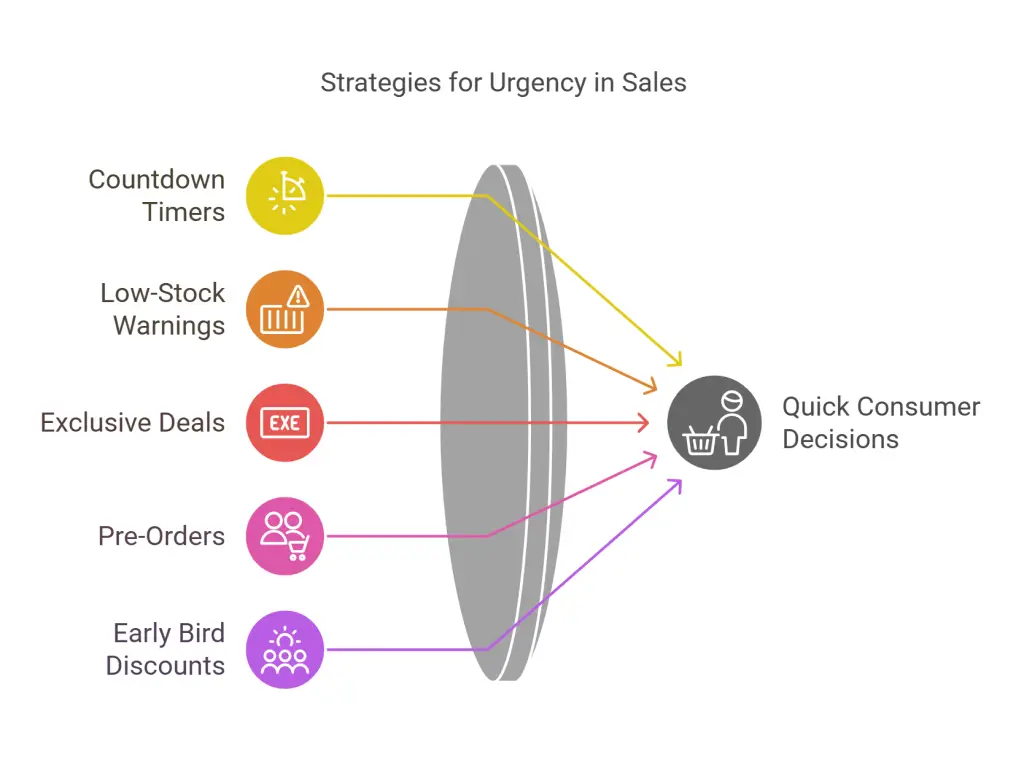
2. Trust & Security
How fear of scams and online fraud impact purchase decisions.
Online shoppers naturally worry about giving away personal and financial details. If a website appears suspicious or lacks credible proof of security, shoppers often leave without a second thought.
The importance of trust signals (customer reviews, SSL badges, guarantees).
Whether it’s a small icon confirming secure payment processing or visible customer testimonials, these trust indicators reassure buyers. A secure checkout process doesn’t just protect the customer—it also builds lasting loyalty.
How to Apply This:
- Display trust badges: Prominent symbols like Norton, McAfee, and Verified by Visa highlight data protection measures.
- Highlight customer testimonials and reviews: Real opinions from verified buyers help others see authentic value in your product.
- Offer money-back guarantees: Letting customers know they can receive a refund if unsatisfied lowers perceived risks and encourages more purchases.
Extra Techniques:
- Live chat support: Providing immediate answers to queries eases concerns and creates a personalized shopping experience.
- Behind-the-scenes content: Show how products are made, tested, or ethically sourced. Transparency in quality assurance fosters a sense of security.
When consumers trust a brand, they’re not just making a transaction—they’re developing a relationship. Over time, that trust becomes a cornerstone of loyalty and repeat purchases.
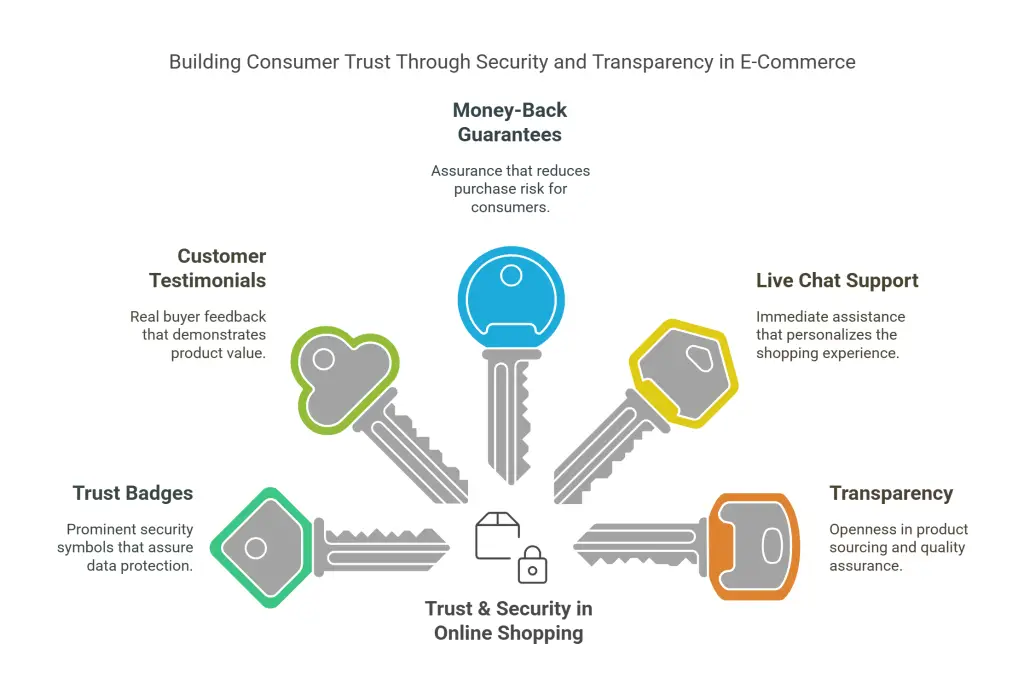
3. Social Proof & Community Validation
Why people follow the crowd—herd mentality in shopping.
Most consumers seek reassurance that others have already purchased and loved a product. This “herd mentality” simplifies the decision process: if it works for many people, it’s likely good for the next shopper too.
The power of seeing others buy, review, and recommend products.
A wall of five-star ratings or endorsements from influencers can resonate more powerfully than any brand-led promotional message. Seeing peers or admired personalities enjoying a product triggers a sense of belonging.
How to Apply This:
- Live purchase notifications: Real-time updates like “Sarah from Melbourne just bought this!” generate excitement and trust.
- User-generated content (UGC): Encourage customers to share photos or videos of them using the product. Featuring these on product pages and social media boosts authenticity.
- Highlight best-seller rankings: A “Trending Now” or “Top Seller” label signals popular demand.
Advanced Social Proof Tactics:
- Influencer testimonials or brand ambassadors: Partner with credible figures whose opinions your target audience respects.
- Referral programs: Reward existing customers for bringing in new buyers, leveraging personal recommendations to build social proof organically.
Social proof is a multi-faceted tool. By blending reviews, real-time notifications, and influencer endorsements, brands can create a vibrant community feeling around their offerings, encouraging those on the fence to join the collective approval.
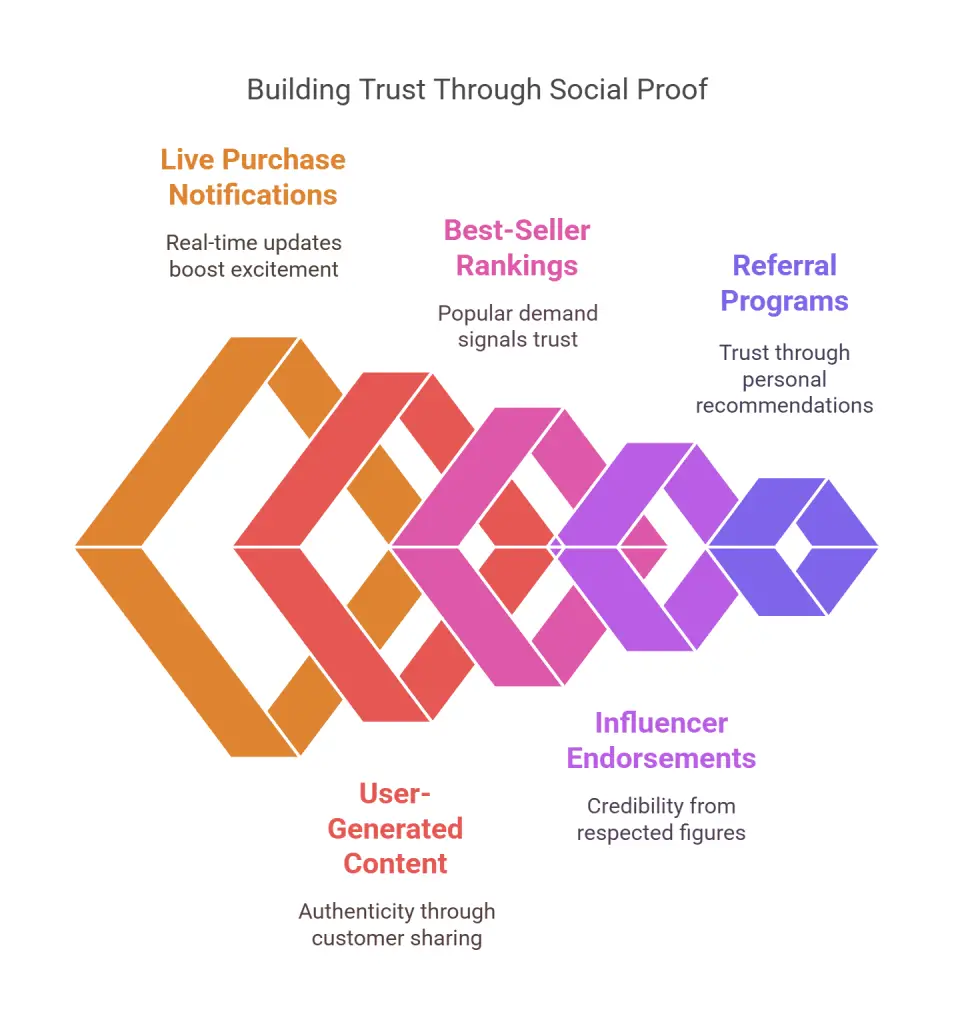
4. Exclusivity & VIP Treatment
Why people crave being part of an “elite” group.
Exclusivity taps into the human desire for recognition and belonging to something special. When shoppers feel like insiders, it boosts their sense of self-worth and encourages deeper engagement with the brand.
How brands use early access, memberships, and limited editions.
From “members-only” sales to early product launches, creating layers of privilege fosters loyalty. Shoppers who feel rewarded for membership are more inclined to stay long-term customers.
How to Apply This:
- VIP memberships: Offer tiers of membership with perks like free shipping, birthday gifts, or private online events.
- Early access to product drops: Let subscribers shop first for hot items. This not only raises perceived value but also forges a sense of gratitude toward the brand.
- Members-only deals and bundles: Limited edition product bundles or special discounts available solely to loyal customers make individuals feel recognized and rewarded.
More Ways to Enhance Exclusivity:
- Personalized recommendations: Analyze past purchases to suggest relevant, exclusive items.
- Loyalty points: Points that unlock higher-level rewards cultivate repeat buying behavior.
When a brand successfully positions its offerings as “not for everyone,” it motivates customers to keep coming back for that coveted insider status. Exclusivity fuels pride, which can translate into enthusiastic advocacy.
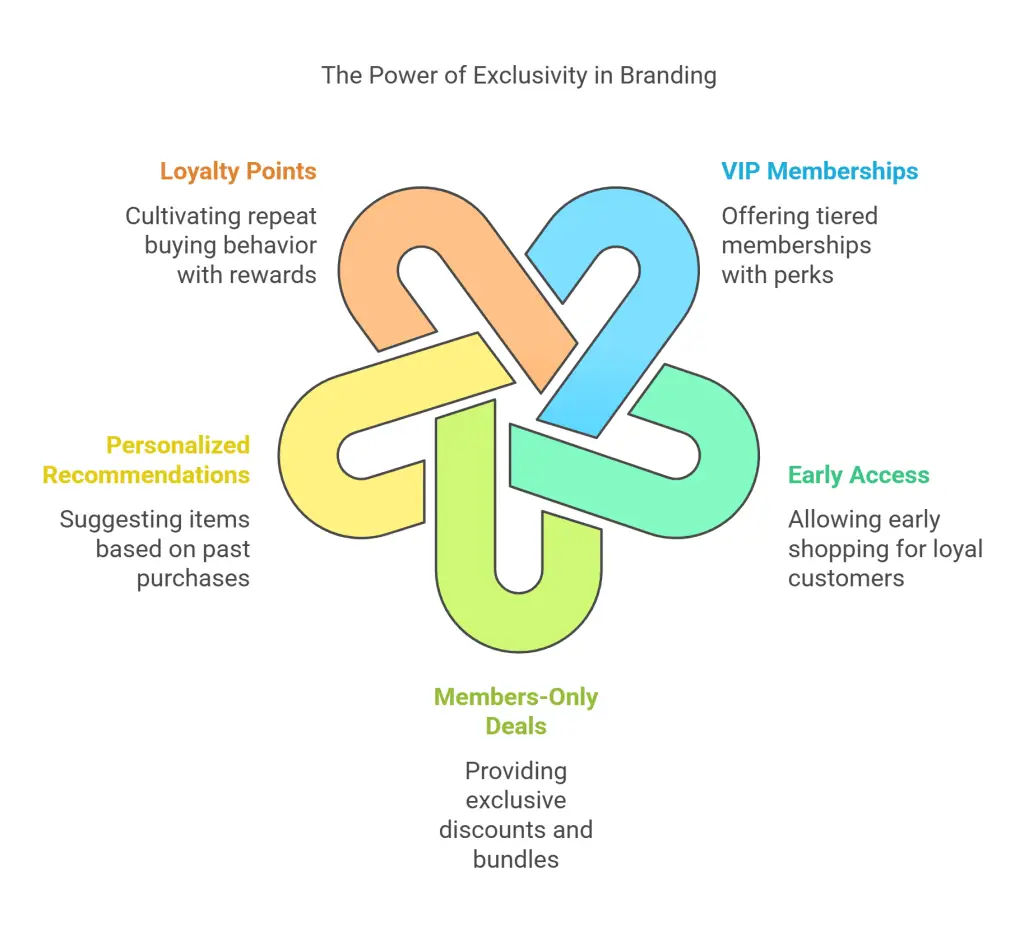
5. Fear & Loss Aversion
Why losing a good deal feels worse than missing out on a gain.
Human psychology often places more weight on losses than gains. The concept of “missing out” or “losing” potential savings or benefits carries a heavier emotional burden than the prospect of gaining something else.
Examples: Money-back guarantees, free trials, and risk-free purchases.
These strategies reassure shoppers that if anything goes wrong or doesn’t meet expectations, they have recourse. This sense of security directly reduces resistance at the point of purchase.
How to Apply This:
- Urgent phrases: Headlines like “Last chance!” or “Don’t miss out!” evoke a sense of finality.
- Risk-free trials: Offer customers a limited window to test products without full commitment.
- Hassle-free return policies: Make the return or refund process straightforward and transparent to reduce second thoughts.
Additional Insights:
- Highlight potential savings: Display how much they’re saving when a discount is applied (e.g., “You saved $50 today!”).
- Loss-framing: Instead of “Buy for $99,” phrase it as “Don’t lose the chance to save $30 off the usual $129.”
By focusing on what the shopper might lose—time, money, or a rare opportunity—brands can provoke a stronger emotional response and more immediate action.
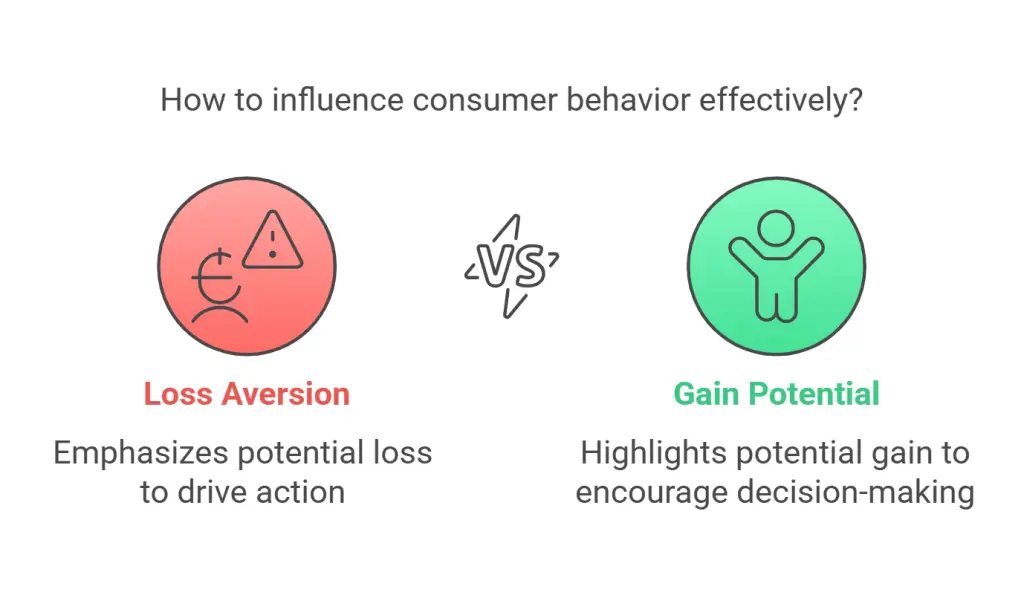
6. Convenience & Instant Gratification
How fast checkouts and express shipping impact impulse buying.
In the digital realm, friction can derail even the most determined shopper. Slow loading times, complicated checkouts, or unknown shipping dates can lead to abandoned carts. Quick solutions, on the other hand, spur instant satisfaction.
The psychology behind one-click purchases and “Buy Now, Pay Later” (BNPL).
Seamless checkout experiences remove obstacles that cause second thoughts. BNPL options reduce the immediate financial burden, making it mentally easier to hit “Confirm Purchase.”
How to Apply This:
- One-click checkout: Integrate digital wallets like Apple Pay or Google Pay so returning customers don’t need to re-enter details.
- Same-day shipping options: If feasible, highlight quick delivery. Waiting less time for a product aligns with today’s “want it now” mentality.
- Chatbots or AI assistants: Rapid, automated answers to frequently asked questions help move the transaction along without requiring customers to leave the page.
Advanced Convenience Strategies:
- Auto-replenishment: Perfect for subscription-based items like beauty products or consumables, ensuring customers never run out and don’t have to revisit the ordering process.
- Voice shopping: As smart speakers become common, enabling voice-activated purchases can remove traditional barriers altogether.
Appealing to convenience and speed creates a sense of immediate reward, encouraging shoppers to act on impulses rather than dwelling on potential drawbacks.
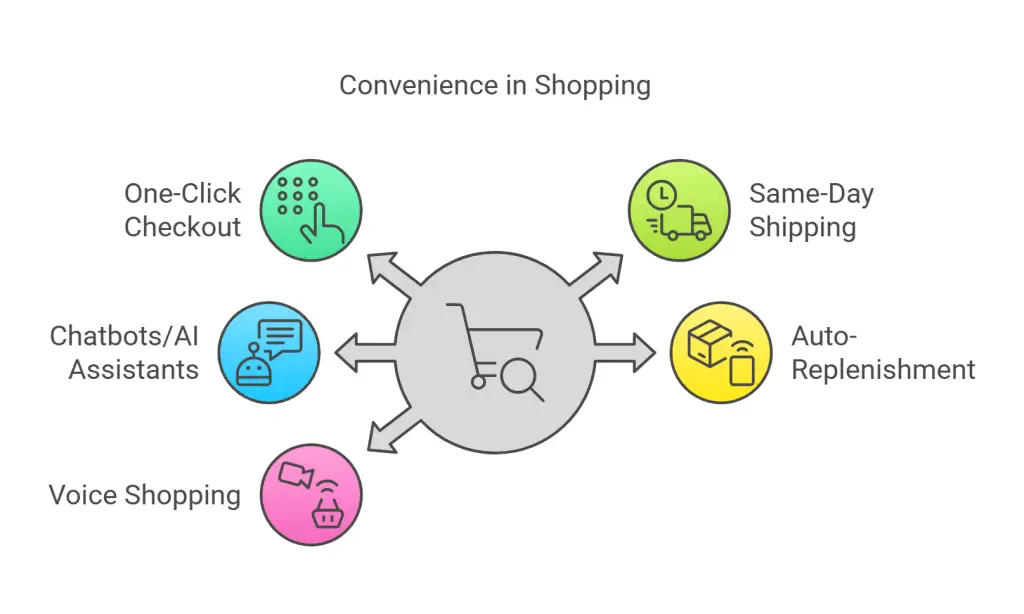
7. Happiness & Aspirational Marketing
Why people buy based on emotions like joy, pride, and success.
People often shop not merely for the function of a product, but for how it makes them feel. Emotional resonance—whether it’s joy from a beautiful design or pride in supporting a meaningful cause—elevates a purchase into a personal statement.
How brands use storytelling and lifestyle imagery to create desire.
Images of satisfied customers, scenic backgrounds, or transformative “before-and-after” stories spark imagination. Shoppers may envision themselves achieving similar outcomes, fueling that “I want to feel like that too” response.
How to Apply This:
- Uplifting, story-driven campaigns: Videos or blog posts sharing real customer journeys (e.g., weight loss stories, personal success narratives) that connect on an emotional level.
- Customer success stories: Show actual transformations or life improvements that your product enabled.
- Align with positive emotions: Whether it’s empowerment, joy, or confidence, highlight these feel-good elements in product descriptions and marketing materials.
Extra Enhancements:
- Positive testimonials: Reviews focusing on how your product made someone’s life better resonate at a deeper level than generic, technical feedback.
- Motivational messaging: Phrases like “Become the best version of yourself” or “Start your journey to a brighter day” help customers imagine a successful outcome.
Happiness-driven marketing thrives on painting a vivid picture of the desired end state. This future-focused optimism positions the product as a gateway to living a more fulfilling life.
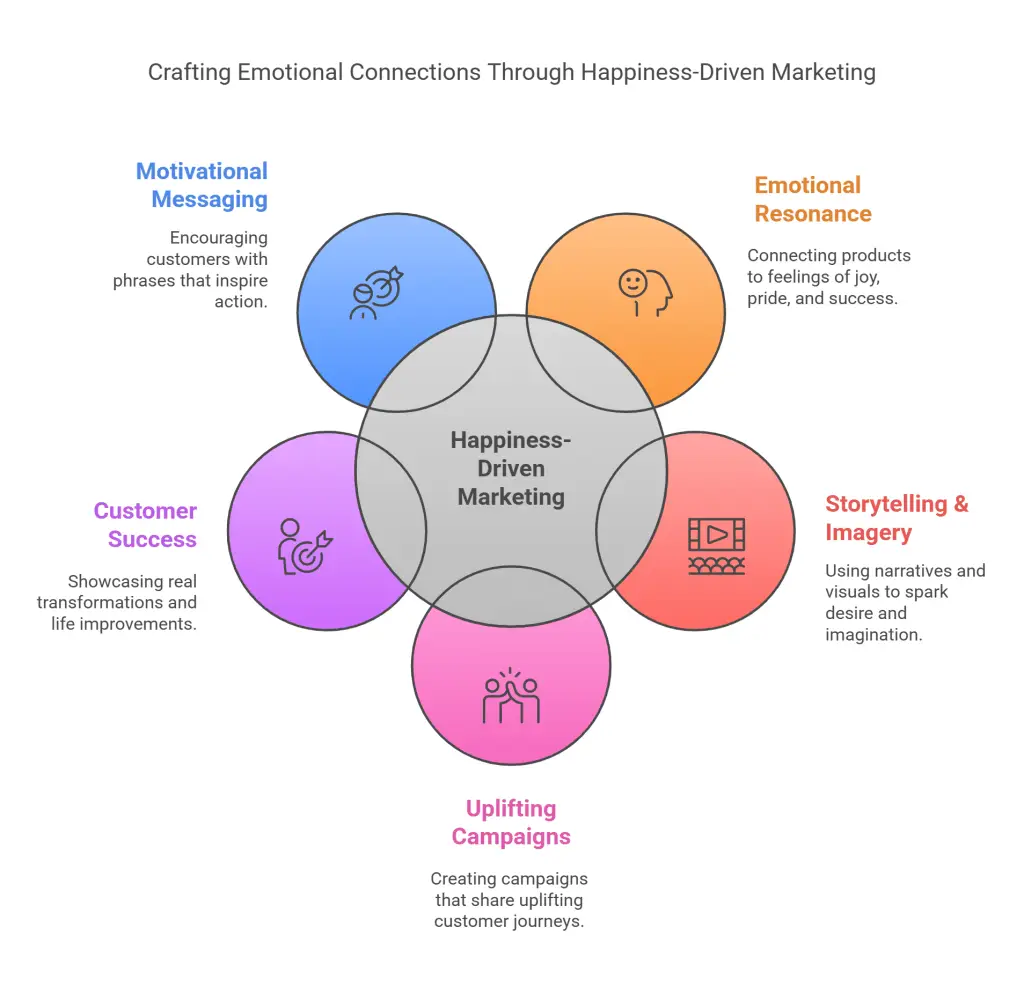
BellaGlow Skincare’s Success with Emotional Marketing
Business Overview:
BellaGlow Skincare emerged onto the beauty scene with promising formulations but faced a disconnect: high website traffic that rarely converted into actual sales.

What They Changed:
- Trust signals: They featured before-and-after images, emphasized dermatologist recommendations, and shared behind-the-scenes testing procedures to ease skepticism.
- Urgency tactics: Limited-edition holiday gift sets, paired with real-time low-stock notifications, drove buyers to finalize orders.
- Social proof: Testimonials from beauty influencers and everyday users provided community validation that helped skeptics trust the brand.
The Results:
BellaGlow saw a 40% uplift in conversions almost immediately. Cart abandonment rates dropped significantly, and repeat customers increased by 25%. By weaving emotional triggers like trust, urgency, and social proof into the entire shopping journey, they kept buyers engaged from first click to checkout.
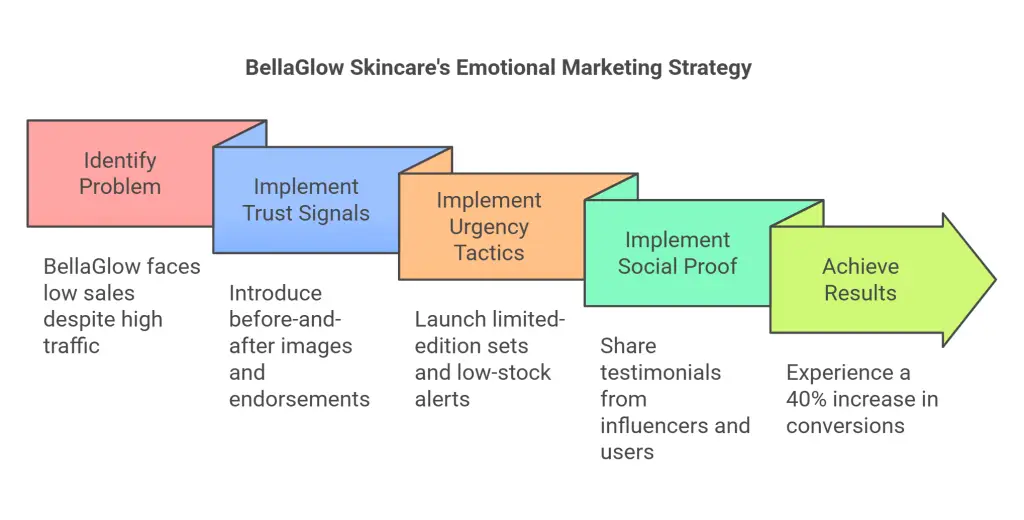
The Science Behind Emotional Shopping Triggers
Each of the emotional triggers—from fear of missing out to the allure of instant gratification—stems from innate cognitive biases and emotional responses. When people encounter a new product or brand, the amygdala (the part of the brain that deals with emotions) often reacts before the prefrontal cortex (the rational decision-making area) can weigh in. This process helps explain why a shopper might instantly feel compelled to purchase without a lengthy rational analysis.
Cognitive biases such as loss aversion further amplify these triggers. People are inclined to avoid loss more than they seek equivalent gains. This is why countdown timers, low-stock alerts, and last-chance offers align so naturally with deeper psychological impulses. By the time logic tries to catch up, the emotional desire often wins.
Emotional experiences also have a lingering effect on memory and brand perception. A positive emotional journey—sparked by user-friendly design, compelling imagery, or a sense of community—builds stronger brand recall. Over time, these positive associations reinforce loyalty, as customers associate the brand with feelings of excitement, trust, or relief from fear.
Different emotions can serve different strategic purposes. For instance, nostalgia can be used to invoke warm, comforting memories, while urgency or exclusivity triggers the need for immediate action. Successful marketers often blend multiple emotional cues, creating an interplay that resonates with a broader audience. Understanding these mechanisms is the cornerstone of ethical, effective emotional marketing.
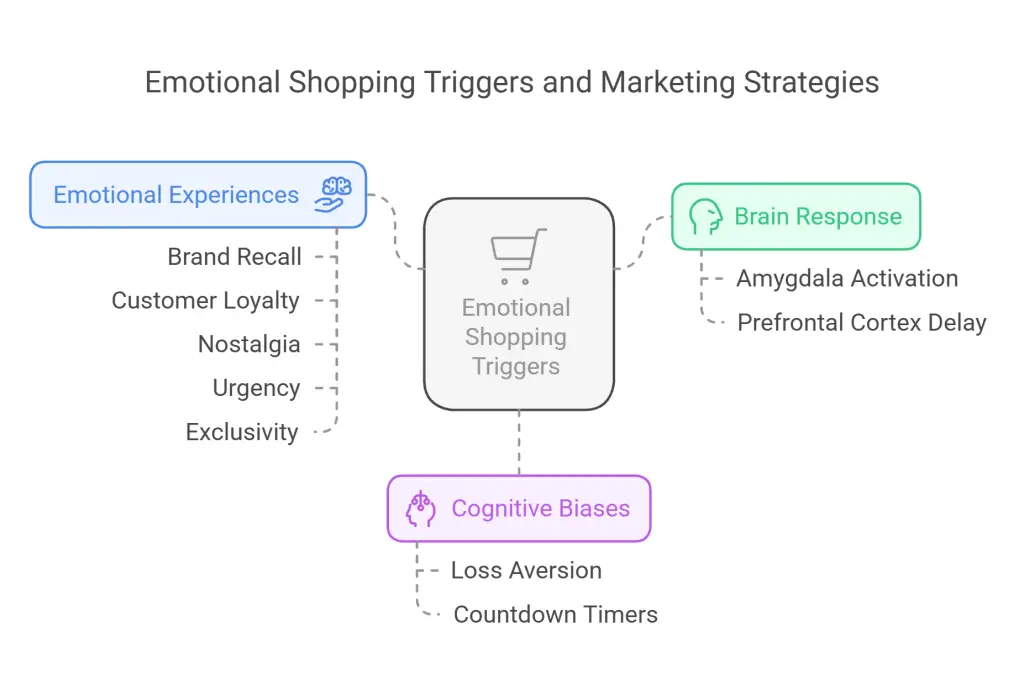
Ethical Considerations in Emotional Marketing
Incorporating emotional triggers into marketing strategies raises questions about where persuasion ends and manipulation begins. While it’s crucial to drive conversions, it’s equally important to respect consumers’ autonomy and wellbeing. Effective emotional marketing should be transparent and grounded in genuine value. For instance, if you claim an offer is “limited-time,” ensure that it’s truly limited, rather than repeatedly extending the deadline.
Here are a few guidelines to keep efforts ethical while still leveraging strong emotional cues:
- Honesty in scarcity claims: Don’t fabricate stock levels or time constraints. Real urgency fosters trust; false urgency breeds skepticism.
- Authentic testimonials: Ensure that customer reviews or influencer endorsements are genuine. Fabricated or heavily edited feedback can damage credibility if discovered.
- Fair return policies: Offering a money-back guarantee but making the process extremely difficult undermines trust. If you showcase risk-free trials, honor them fully.
The crux of ethical emotional marketing is mutual benefit: the shopper gains a product that genuinely meets their needs, while the business grows sustainably. When emotional triggers are applied responsibly, they enhance customer experiences rather than exploiting vulnerabilities. This approach cultivates loyal relationships that last beyond a single sale.
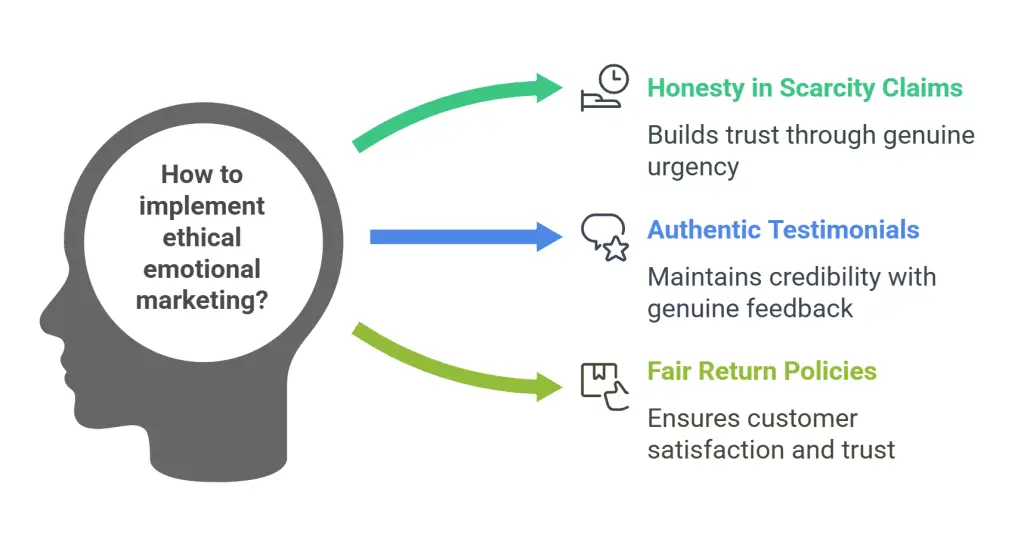
The Impact of Social Media on Emotional Shopping Triggers
Social media platforms amplify emotional triggers by allowing content to travel instantly through networks of friends, influencers, and interest groups. A compelling Facebook ad or Instagram story can spark powerful responses—urgency, excitement, or curiosity—across hundreds, thousands, or even millions of viewers in a short time.
- Viral trends and FOMO: Hashtags, memes, and viral challenges create a sense of community, inspiring people to join in. Once users see friends or influencers endorsing a product, they may experience FOMO and want to try it too.
- Storytelling opportunities: Platforms like Instagram Reels or TikTok let brands share short, narrative-driven content. An emotional arc—like showing a transformation process—can be more persuasive than static ads.
- Interactive engagement: Live streams, polls, and Q&A sessions allow consumers to interact with brands and other fans in real time. This shared community experience reinforces trust, exclusivity, and social proof.
To harness the power of social media effectively, ensure consistency in messaging. If your brand thrives on exclusivity, maintain that tone across all platforms. If social proof is your main driver, encourage user-generated content at every turn. Emotional triggers that are scattered or contradictory can dilute their impact. Focus on cohesive storytelling so that each emotional hook supports the others in building a compelling brand image.
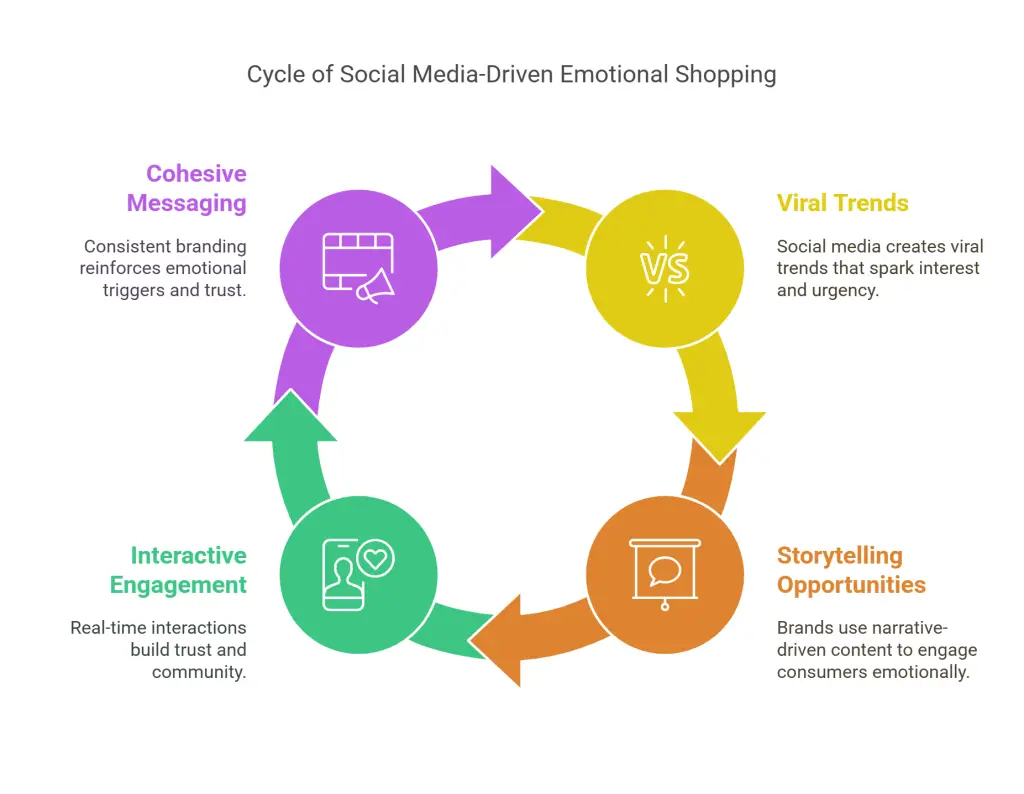
The Future of Emotional Marketing in E-Commerce
Technological innovations and evolving consumer expectations are set to intensify the role of emotional triggers. Here’s how the landscape may evolve:
- AI and predictive emotional analytics: Advanced algorithms can analyze real-time user behavior—like how long they hover over a product or which images they click on. Brands can respond instantly, changing website layouts or offering personalized deals based on detected emotions.
- Augmented Reality (AR) and Virtual Reality (VR): Trying on clothes or testing a product experience in a virtual space can deepen emotional engagement. When customers feel immersed in a brand’s story or product environment, the emotional pull becomes more potent.
- Hyper-personalization: Detailed data about past purchases, browsing history, and demographic information enables brands to send highly targeted emotional appeals. Rather than generic offers, each shopper might see deals tailored to their unique fears, aspirations, or desires.
- Evolution of consumer expectations: As people become savvier about marketing tactics, they also expect more authenticity. Over-reliance on flashy countdowns or pushy scarcity messages may backfire if they appear manipulative. Future-proof strategies hinge on a balanced approach that retains real value for the customer.
Marketers looking to excel should stay open to emerging tools that measure emotional responses in ever more subtle ways—eye-tracking, micro-expressions, or even biometric feedback. By integrating these insights ethically, brands can refine their emotional hooks while respecting consumer comfort and privacy.
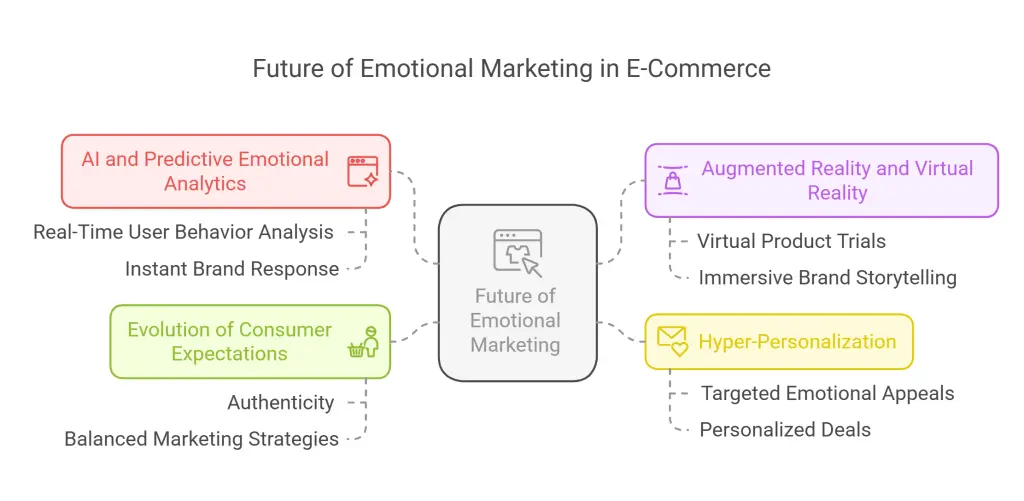
Conclusion: The Power of Emotional Triggers in Online Shopping
Emotions underpin every stage of the customer journey, often driving decisions that logic later rationalizes. This fundamental truth makes emotional triggers some of the most potent tools in an online marketer’s arsenal. A store optimized for trust, urgency, social proof, exclusivity, fear of loss, convenience, and happiness can transform fleeting website visits into meaningful conversions.
Key Takeaways:
- Trust: Security badges, transparent policies, and authentic testimonials build confidence.
- Urgency: Countdown timers, limited-stock alerts, and time-bound promotions push shoppers to act.
- Social Proof: Seeing others enjoy a product—through reviews, photos, or influencer support—creates collective reassurance.
- Exclusivity: VIP memberships and early access strategies feed the desire to belong to a select group.
- Fear & Loss Aversion: The dread of missing out or losing a special deal sparks immediate action.
- Convenience: Smooth checkout processes and quick shipping methods cater to the desire for instant gratification.
- Happiness & Aspirational Marketing: Positive storytelling and lifestyle imagery connect deeply, making the purchase feel like a gateway to a better life.
When shaping your e-commerce strategy, remember that people buy emotions, not products. A product might solve a technical problem, but the emotional aspect of hope, trust, or excitement seals the deal. The best approach blends multiple emotional triggers tailored to your audience, ensuring each visitor finds a compelling reason to move forward.
Success in e-commerce will continue to hinge on tapping into the human side of shopping. While technology becomes more sophisticated, the emotional core of decision-making remains constant. Brands that master these emotional triggers and adapt to changing consumer tastes will forge lasting connections and enjoy consistent growth. By consistently refining and updating your emotional marketing tactics, you’ll stay ahead of the curve and ensure your small business remains a trusted, beloved choice for online shoppers everywhere.
Frequently Asked Questions
Why do emotions play a crucial role in online shopping?
Emotions drive consumer behavior, often before logic. They influence decisions by creating connections, sparking excitement, soothing anxieties, and resonating with aspirations, leading to faster and more confident purchases.
What is the impact of urgency and scarcity on consumer behavior?
Urgency and scarcity tap into the fear of missing out (FOMO), prompting swift decisions. Limited-time offers and low-stock alerts create a sense of loss aversion, encouraging immediate action to avoid missing opportunities.
How does social proof enhance online sales?
Social proof leverages the influence of others’ actions and opinions. Testimonials, reviews, and endorsements build trust and credibility, reassuring potential customers and increasing the likelihood of purchase.
What role does reciprocity play in customer engagement?
Reciprocity involves offering value upfront, such as free resources or discounts, creating a sense of obligation in customers to return the favor, often leading to increased loyalty and sales.
How can businesses utilize authority to boost conversions?
Displaying credentials, certifications, or expert endorsements positions a brand as an authority, instilling trust and confidence in consumers, which can lead to higher conversion rates.
Further reading
Magids, Scott, Alan Zorfas, and Daniel Leemon. “The New Science of Customer Emotions.” Harvard Business Review, November 2015. https://hbr.org/2015/11/the-new-science-of-customer-emotions. (Accessed February 21, 2025).
Tokinomo. “The Role of Emotions in Consumer Decision-Making.” Tokinomo Blog, April 18, 2023. https://www.tokinomo.com/blog/role-emotions-consumer-decision-making. (Accessed February 21, 2025).
Material. “Consumer Psychology 101: What Is Emotion?” Material Plus, 2023. https://www.materialplus.io/perspectives/consumer-psychology-101-what-is-emotion. (Accessed February 21, 2025).
Frontiers in Psychology. “Emotions as Key Drivers of Consumer Behaviors: A Multidisciplinary Perspective.” Frontiers Research Topics, 2023. https://www.frontiersin.org/research-topics/27139/emotions-as-key-drivers-of-consumer-behaviors-a-multidisciplinary-perspective/magazine. (Accessed February 21, 2025).
Explorer Research. “How Emotions Affect Shopper Behavior.” Explorer Research, 2023. https://explorerresearch.com/how-emotions-affect-shopper-behavior/. (Accessed February 21, 2025).
Kellogg Insight. “Take 5: The Surprising Ways Emotions Shape Consumer Behavior.” Northwestern Kellogg School of Management, June 12, 2023. https://insight.kellogg.northwestern.edu/article/take-5-the-surprising-ways-emotions-shape-consumer-behavior. (Accessed February 21, 2025).
Laros, Fleur J. M., and Jan-Benedict E. M. Steenkamp. “Emotions in Consumer Behavior: A Hierarchical Approach.” Journal of Business Research 58, no. 10 (2005): 1437–45. https://www.sciencedirect.com/science/article/abs/pii/S0148296304001092. (Accessed February 21, 2025).



